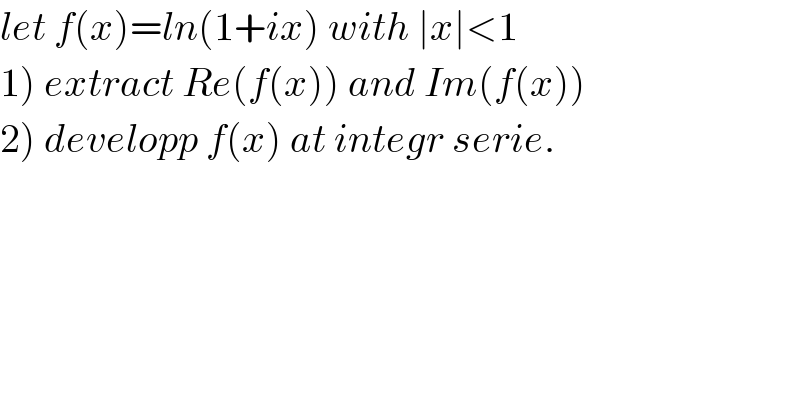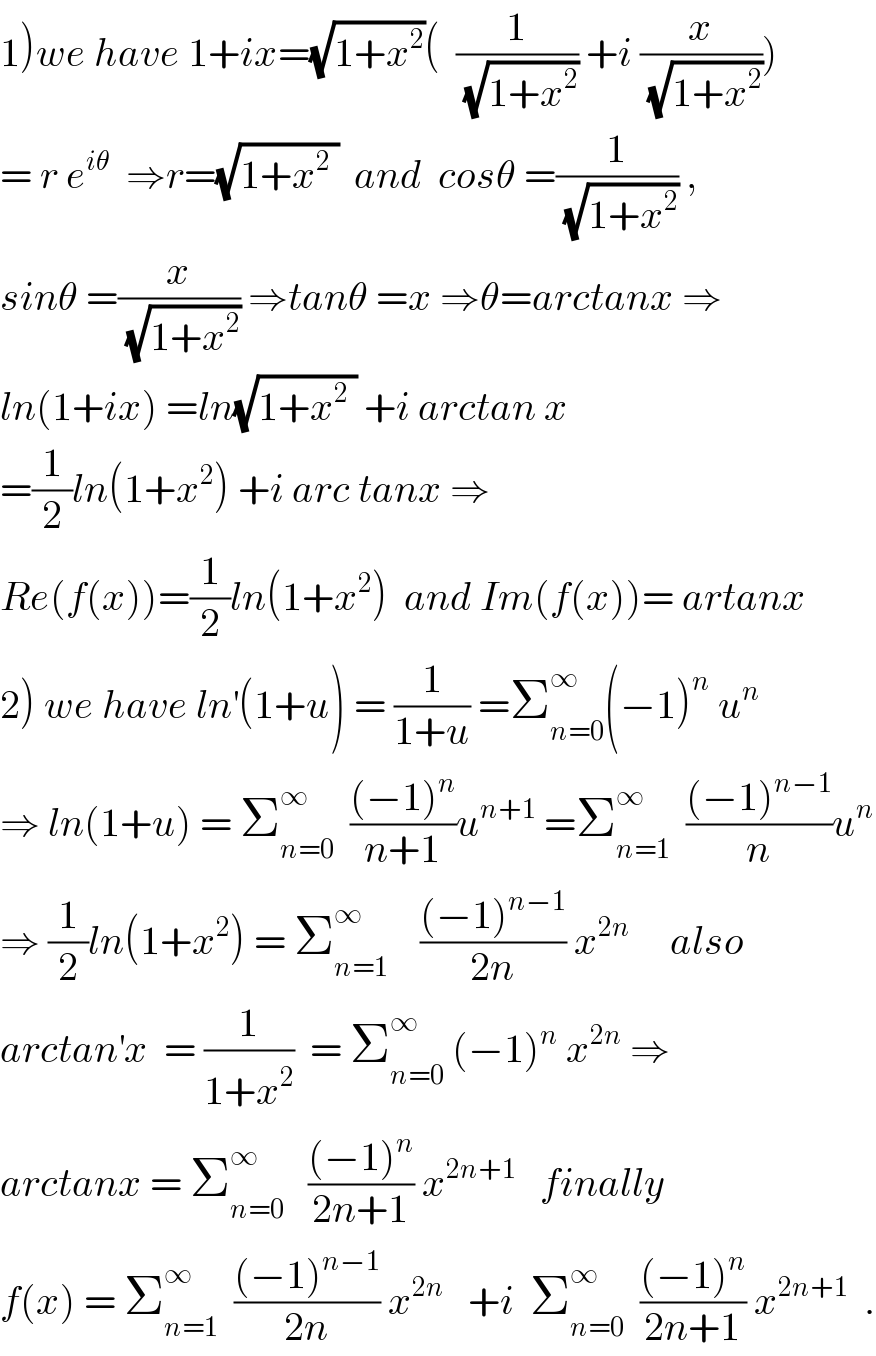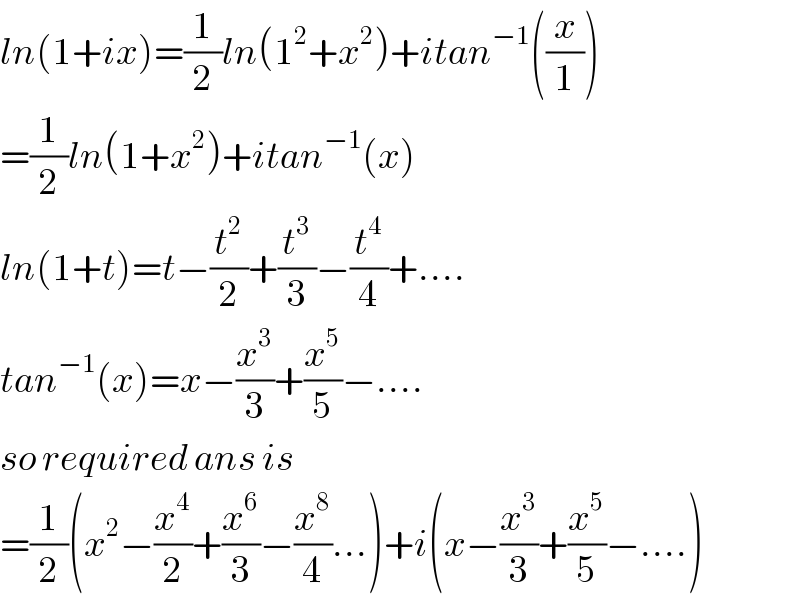
Previous in Relation and Functions Next in Relation and Functions
Question Number 34634 by abdo mathsup 649 cc last updated on 09/May/18

$${let}\:{f}\left({x}\right)={ln}\left(\mathrm{1}+{ix}\right)\:{with}\:\mid{x}\mid<\mathrm{1} \\ $$ $$\left.\mathrm{1}\right)\:{extract}\:{Re}\left({f}\left({x}\right)\right)\:{and}\:{Im}\left({f}\left({x}\right)\right) \\ $$ $$\left.\mathrm{2}\right)\:{developp}\:{f}\left({x}\right)\:{at}\:{integr}\:{serie}. \\ $$
Commented bymath khazana by abdo last updated on 10/May/18

$$\left.\mathrm{1}\right){we}\:{have}\:\mathrm{1}+{ix}=\sqrt{\mathrm{1}+{x}^{\mathrm{2}} }\left(\:\:\frac{\mathrm{1}}{\sqrt{\mathrm{1}+{x}^{\mathrm{2}} }}\:+{i}\:\frac{{x}}{\sqrt{\mathrm{1}+{x}^{\mathrm{2}} }}\right) \\ $$ $$=\:{r}\:{e}^{{i}\theta} \:\:\Rightarrow{r}=\sqrt{\mathrm{1}+{x}^{\mathrm{2}} \:}\:\:{and}\:\:{cos}\theta\:=\frac{\mathrm{1}}{\sqrt{\mathrm{1}+{x}^{\mathrm{2}} }}\:, \\ $$ $${sin}\theta\:=\frac{{x}}{\sqrt{\mathrm{1}+{x}^{\mathrm{2}} }}\:\Rightarrow{tan}\theta\:={x}\:\Rightarrow\theta={arctanx}\:\Rightarrow \\ $$ $${ln}\left(\mathrm{1}+{ix}\right)\:={ln}\sqrt{\mathrm{1}+{x}^{\mathrm{2}} \:}\:+{i}\:{arctan}\:{x} \\ $$ $$=\frac{\mathrm{1}}{\mathrm{2}}{ln}\left(\mathrm{1}+{x}^{\mathrm{2}} \right)\:+{i}\:{arc}\:{tanx}\:\Rightarrow \\ $$ $${Re}\left({f}\left({x}\right)\right)=\frac{\mathrm{1}}{\mathrm{2}}{ln}\left(\mathrm{1}+{x}^{\mathrm{2}} \right)\:\:{and}\:{Im}\left({f}\left({x}\right)\right)=\:{artanx} \\ $$ $$\left.\mathrm{2}\right)\:{we}\:{have}\:{ln}^{'} \left(\mathrm{1}+{u}\right)\:=\:\frac{\mathrm{1}}{\mathrm{1}+{u}}\:=\sum_{{n}=\mathrm{0}} ^{\infty} \left(−\mathrm{1}\right)^{{n}} \:{u}^{{n}} \\ $$ $$\Rightarrow\:{ln}\left(\mathrm{1}+{u}\right)\:=\:\sum_{{n}=\mathrm{0}} ^{\infty} \:\:\frac{\left(−\mathrm{1}\right)^{{n}} }{{n}+\mathrm{1}}{u}^{{n}+\mathrm{1}} \:=\sum_{{n}=\mathrm{1}} ^{\infty} \:\:\frac{\left(−\mathrm{1}\right)^{{n}−\mathrm{1}} }{{n}}{u}^{{n}} \\ $$ $$\Rightarrow\:\frac{\mathrm{1}}{\mathrm{2}}{ln}\left(\mathrm{1}+{x}^{\mathrm{2}} \right)\:=\:\sum_{{n}=\mathrm{1}} ^{\infty} \:\:\:\:\frac{\left(−\mathrm{1}\right)^{{n}−\mathrm{1}} }{\mathrm{2}{n}}\:{x}^{\mathrm{2}{n}} \:\:\:\:\:{also} \\ $$ $${arctan}^{'} {x}\:\:=\:\frac{\mathrm{1}}{\mathrm{1}+{x}^{\mathrm{2}} }\:\:=\:\sum_{{n}=\mathrm{0}} ^{\infty} \:\left(−\mathrm{1}\right)^{{n}} \:{x}^{\mathrm{2}{n}} \:\Rightarrow \\ $$ $${arctanx}\:=\:\sum_{{n}=\mathrm{0}} ^{\infty} \:\:\:\frac{\left(−\mathrm{1}\right)^{{n}} }{\mathrm{2}{n}+\mathrm{1}}\:{x}^{\mathrm{2}{n}+\mathrm{1}} \:\:\:{finally} \\ $$ $${f}\left({x}\right)\:=\:\sum_{{n}=\mathrm{1}} ^{\infty} \:\:\frac{\left(−\mathrm{1}\right)^{{n}−\mathrm{1}} }{\mathrm{2}{n}}\:{x}^{\mathrm{2}{n}} \:\:\:+{i}\:\:\sum_{{n}=\mathrm{0}} ^{\infty} \:\:\frac{\left(−\mathrm{1}\right)^{{n}} }{\mathrm{2}{n}+\mathrm{1}}\:{x}^{\mathrm{2}{n}+\mathrm{1}} \:\:. \\ $$
Answered by tanmay.chaudhury50@gmail.com last updated on 09/May/18

$${ln}\left(\mathrm{1}+{ix}\right)=\frac{\mathrm{1}}{\mathrm{2}}{ln}\left(\mathrm{1}^{\mathrm{2}} +{x}^{\mathrm{2}} \right)+{itan}^{−\mathrm{1}} \left(\frac{{x}}{\mathrm{1}}\right) \\ $$ $$=\frac{\mathrm{1}}{\mathrm{2}}{ln}\left(\mathrm{1}+{x}^{\mathrm{2}} \right)+{itan}^{−\mathrm{1}} \left({x}\right) \\ $$ $${ln}\left(\mathrm{1}+{t}\right)={t}−\frac{{t}^{\mathrm{2}} }{\mathrm{2}}+\frac{{t}^{\mathrm{3}} }{\mathrm{3}}−\frac{{t}^{\mathrm{4}} }{\mathrm{4}}+.... \\ $$ $${tan}^{−\mathrm{1}} \left({x}\right)={x}−\frac{{x}^{\mathrm{3}} }{\mathrm{3}}+\frac{{x}^{\mathrm{5}} }{\mathrm{5}}−.... \\ $$ $${so}\:{required}\:{ans}\:{is} \\ $$ $$=\frac{\mathrm{1}}{\mathrm{2}}\left({x}^{\mathrm{2}} −\frac{{x}^{\mathrm{4}} }{\mathrm{2}}+\frac{{x}^{\mathrm{6}} }{\mathrm{3}}−\frac{{x}^{\mathrm{8}} }{\mathrm{4}}...\right)+{i}\left({x}−\frac{{x}^{\mathrm{3}} }{\mathrm{3}}+\frac{{x}^{\mathrm{5}} }{\mathrm{5}}−....\right) \\ $$
